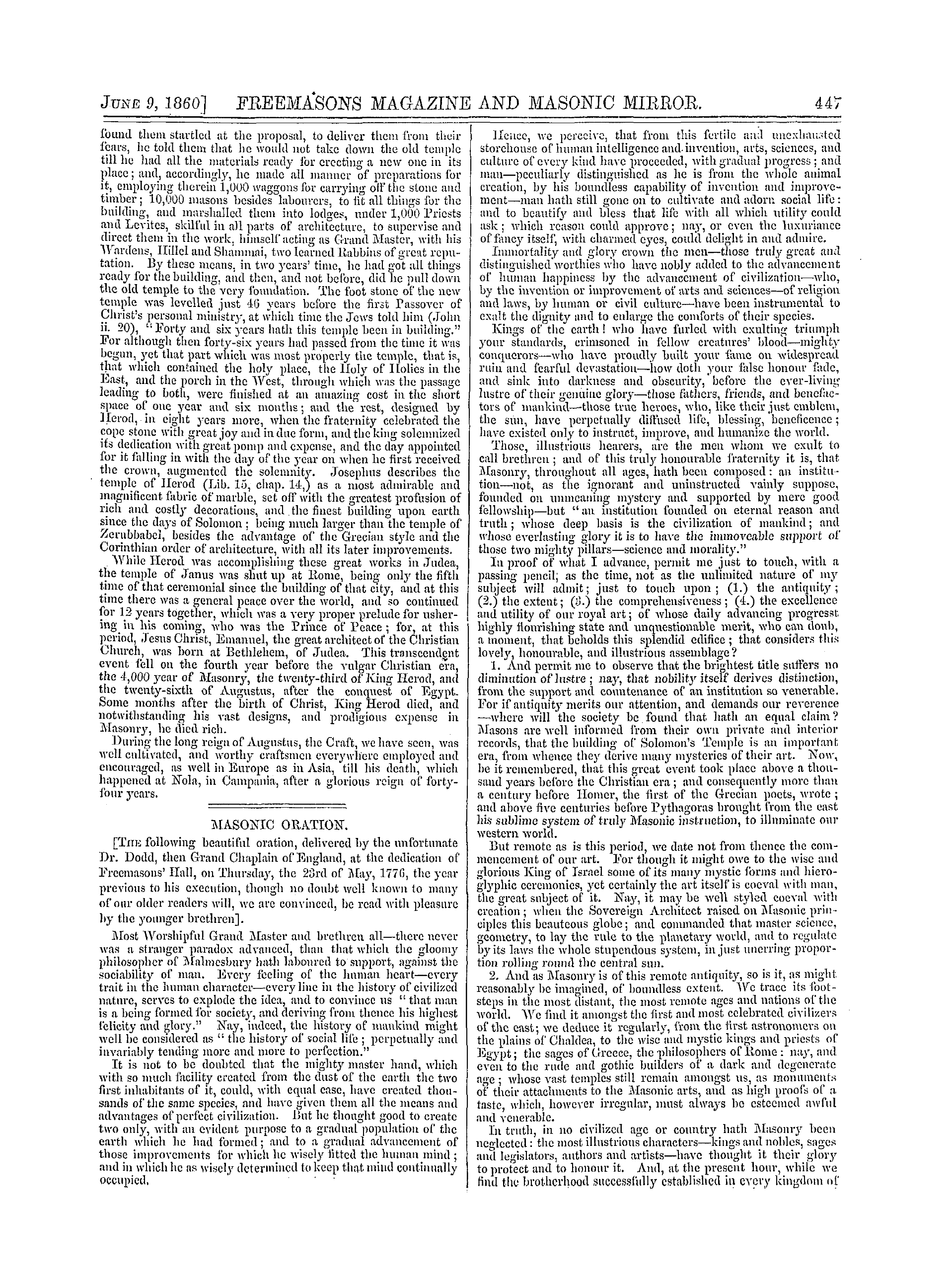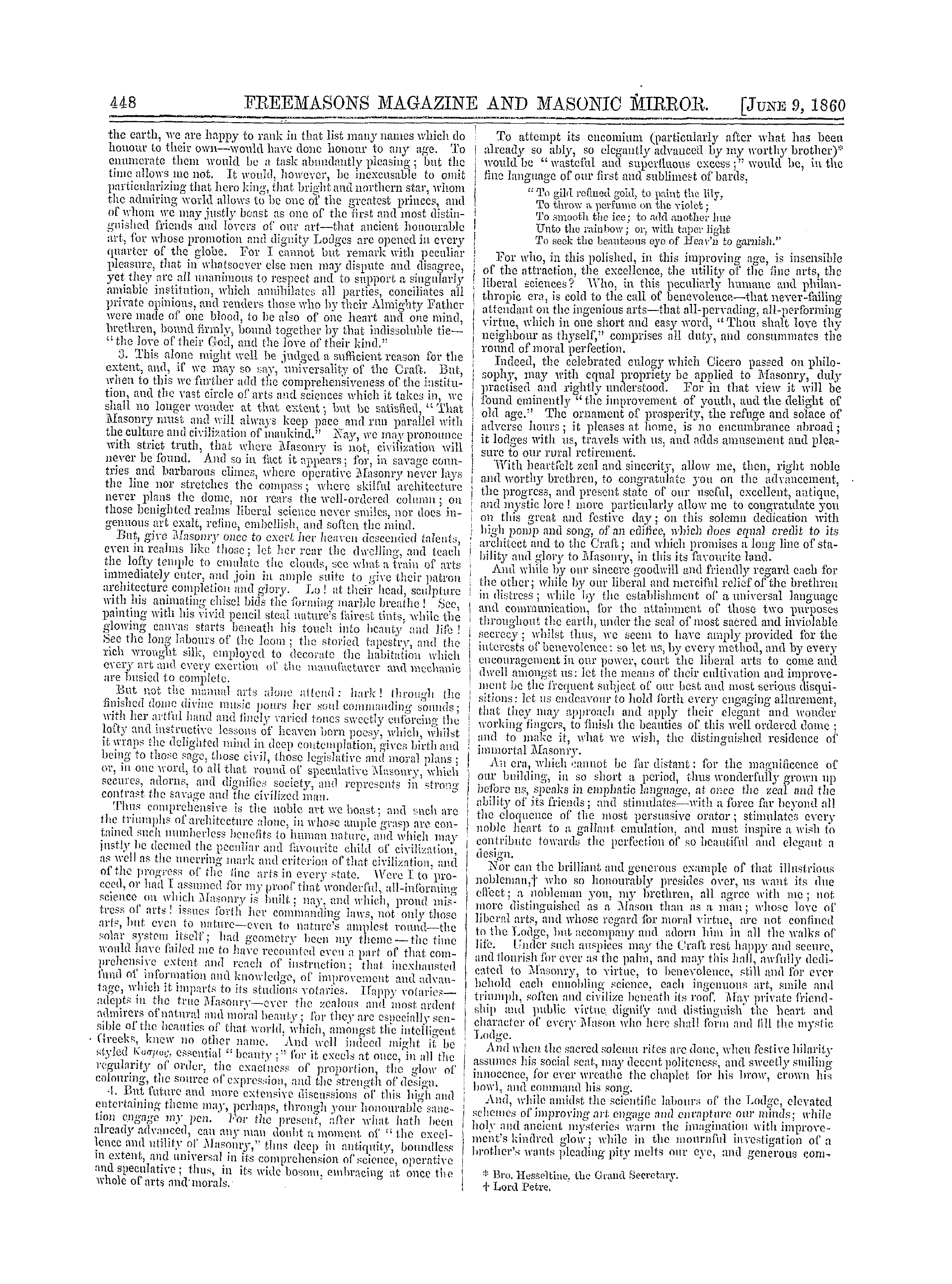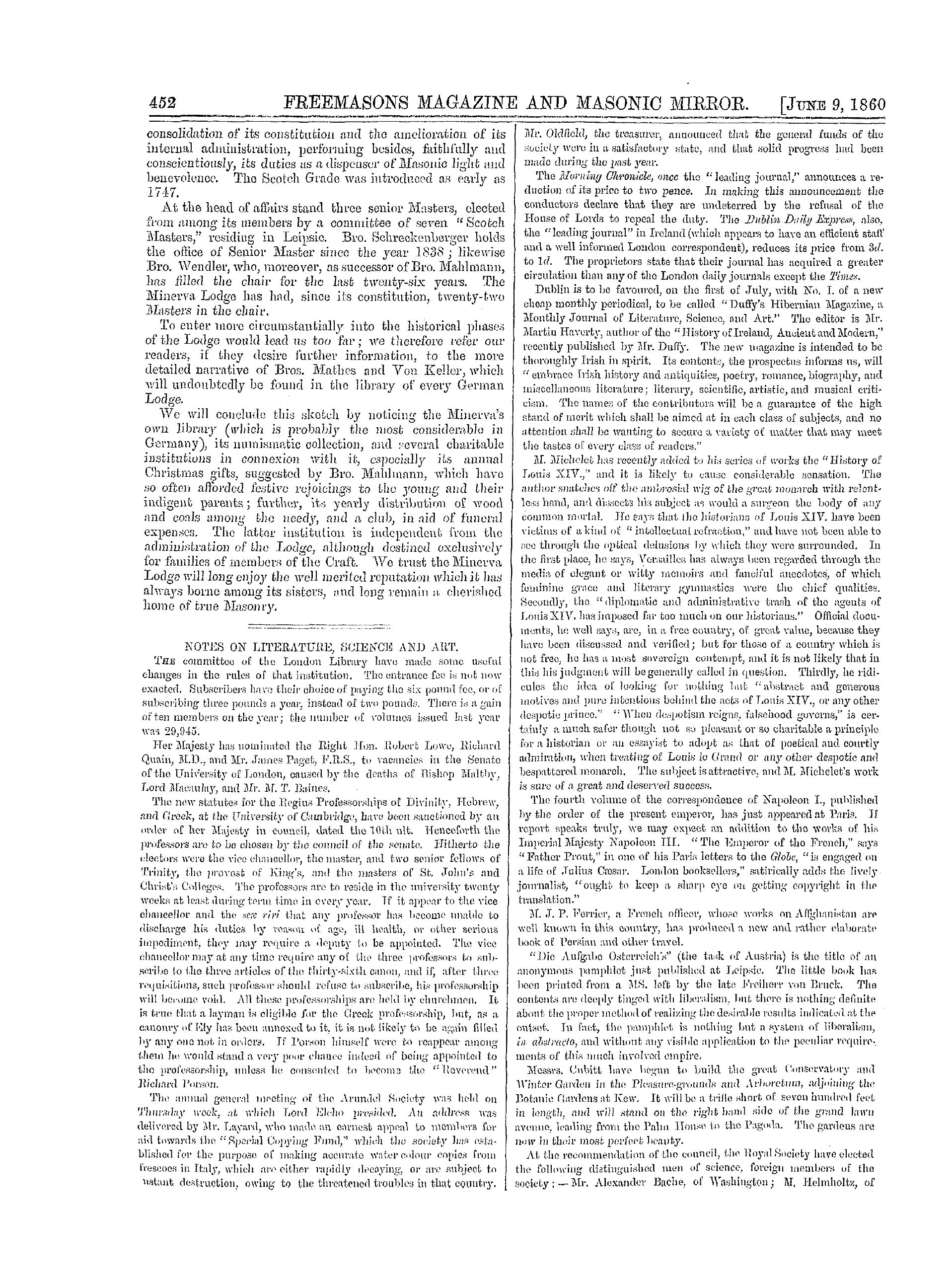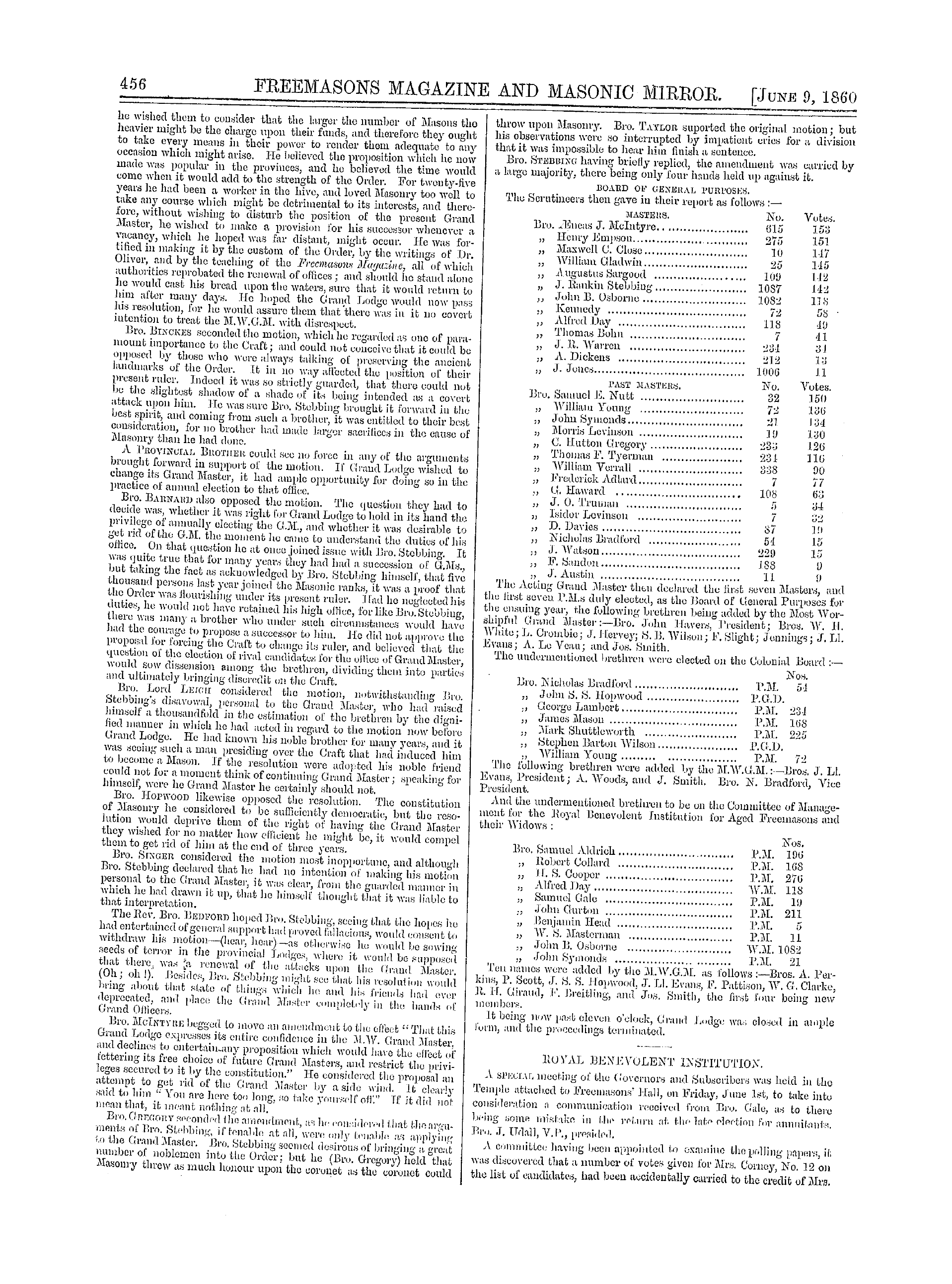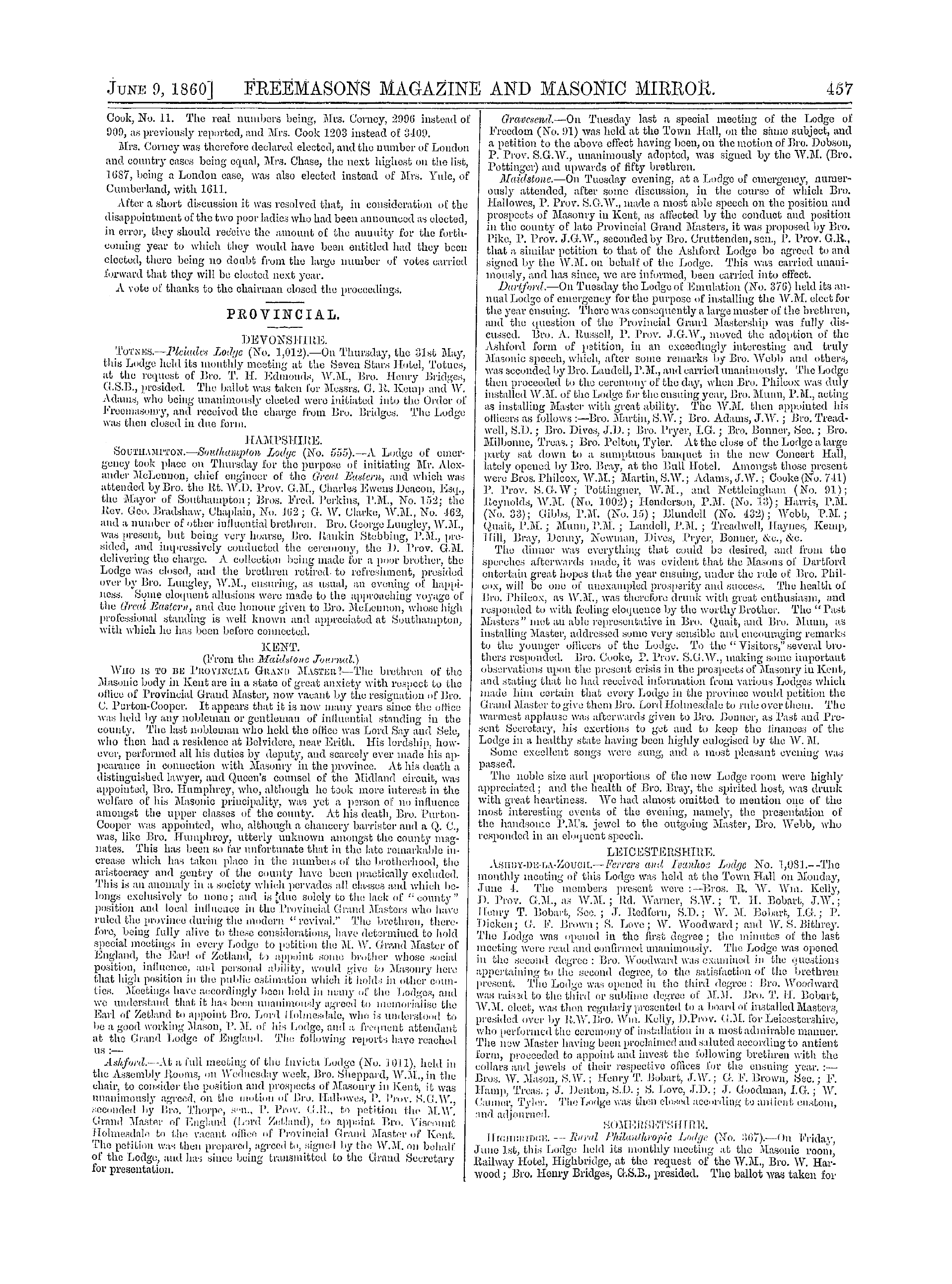Note: This text has been automatically extracted via Optical Character Recognition (OCR) software.
Masterpieces Of The Architecture Of Different Nations.
compose the seven files of their enclosure . * I find also , iu looking in this light at tho temple aud its cello , , that six casements and the door afford seven openings ; that four columns without and eight within form the number twelve , applicable to the months of thc year ; that the four angular pilasters might equally be applied to the four seasons ; aud
that , finally , by counting the forty-two columns of the peristyle of the temple ancl the four antai , the two angular columns at the east front , with the four columns of the cella , the number fifty-two would be obtained , which exactly corresponds to that of the weeks . The number of the flights of steps which surround the temple is also seven and
; I abstain from counting the genii or the garlands which enrich the frieze , and in which there might be also found numbers which correspond with all the other divisions of time used by the ancients . It is sufficient for me to have directed the attention of antiquaries in this direction , in order to jilace those on the road who are desirous of
extending their combinations on this subject . It is scarcely possible to place a door , the mass of ivhich besides is so beautiful , in a more ridiculous manner than that in ivhich cuts the lateral colonnade of the Temple of the Sun . We cannot do less , for tlie honour of antiquity , than suppose that it was so adjusted since the restoration of the
temple after its partial destruction b y the legions of Aurelian . The regular distribution of the columns in the opposite part of the peristyle proves that the plan had been conceived acccrding to the usage and the proportions of the Greeks , but that it was thus dishonoured in that restoration . The
coarse execution oi the sculpture of this part in comparison with that of the rest of the temple , contributes furthermore to the support of this ojiiiiion ; and I am inclined to think that in its primitive construction there were entrances to the interior of it by one or several openings , which corresponded to those cf the inter-columuiations . Moreover , the most
estimable monuments of the architecture of tho ancients frequently present to us , by the side of the greatest beauties , these singular negligences ; the same as we see iu the poems of Homer , by the side of the most sublime bits , passages in ivhich tlie elevated genius of the first of poets is no longer recognised .
If the different fronts of the enclosure of this Temple of the Sun are examined in the work published by M . Cassas ou Syria , t we shall be struck at the resemblance of this architecture with that ivhich Perrault has chosen for the
decoration of the peristyle of the Louvre , and of the faQade towards the river . The resemblances are so like in so many respects , that one cannot believe that this edifice at Palmyra could have been unknown to him . J . There is even found in it the example of the coupling of columns , that was then regarded as a very brilliant modern invention , and that nowadays good
taste would reject , in spite of the authority of a monument of antiquity , as a vice in decoration , and an infringement of the laws of simplicity and purity , which are , above all , required to be obeyed in the choice productions of architecture . The Portico of the Merchcoils , or the Exchange , at Palmyra . —This monument , of a kind altogether new as to its
disposition , seems to us as if it could not have been applied moro happily among a rich and commercial people than to a kind of Exchange , or portico for the merchants . Indeed , they could walk in the shade , and talk over business privately , under the porticoes at the side , and then assemble again in a room iu the centre , the circular part of whicli at the bottom seems very applicable for a tribunal to decide disputes relating to commerce .
It is thought that it mig ht- have been erected towards the time of Diocletian . The apj . licatioii of it mig ht be made amongst us to several public establishments ; but , above all , it ivould be suited perfectly for an exchange , a custom house , a corn or coal exchange , a building to receive and shelter bankersmerchantstravellersifcc . Thc changeable !) ess of
, , , our climate would oblige us only to close , at least during winter , the exterior intercolumiiiations with panes of glass , for which mig ht be substituted jalousies or Venetian blinds in summer .
The Temple of Neptune , whicli , terminated ihe ( great gallery on the side of the mountains . —The remarkable position of this monument between four tombs in the form of towers , at the extremity of the gallery of which it makes the most conspicuous object ; its form and thc choice of its ornaments , —all must incline us to believe witli M . Cassas that it was not a
tomb , but a temple . As to its dedication to the god Neptune , as there is no inscription to prove this , it may be supposed to have been the case iu consequence of a rich ceiling found iu its ruins representing , in bets relief , a Triton and a Nereid playing in the midst of waves , and appearing there embraced by the fires of
love . Other symbolical ornaments of the god of the waters tend finally to render this supposition very probable . This temple was of the kind of those which Vitruvius calls prostyle , with a single portico ; hexastyle , with six columns in front , ifcc ., and the cella of which had amice enriched with ornaments . It is true that the plan of this cello , was square
instead of being , as was usual , oblong ; it contained a group of four small columns upon a pedestal , forming a kind of covered altar to receive , no doubt , the statue of the god . Under each column of its portico is a pedestal of very low proportion , unornamented by any moulding ; its corona and base are so simply formed that perhaps this part may never have been finished .
The proportions of the temple are beautiful ; the columns are nearly three feet in diameter , of the Corinthian order , without channelling , and but nine diameters and a half in height ; the inter-columniations are close together ; the Greek character is distinguishable in tlie profiles of the entablature , the hei ght of whicli is a quarter of the order . It is
embellished with ornaments , and the frieze enriched , as we have already intimated , with waves of water , worked with grace and smoothness ; but the oblong modillions are without any sculpture , as well as the architrave . Two Pedestals loith the ei ght columns which decorated the middle of the great gallery , the trmmphed monument at
Palmyra . —These two pedestals receive each a group of four columns ; the entablature sheltered a statue , and they stood in the great gallery opposite the largest of the transversal streets whicli crossed it at right angles . This triumphal adjustment , which has the greatest effect , is absolutely new in architectureand particularly in that of Palmyra ; no
, monument of antiquity offers an example of it ; it is to bo hoped that it will be soon reproduced by the moderns , in order that they may enjoy the charm of its execution . These four groups of columns must have produced the most agreeable effect on those who beheld it while walking in the gallery . They made a necessary variety in that uniformity of
intercolumiiiations , and a point of union of the most magnificent kind for tlie meeting of the two great galleries , ivhich must have presented to any one standing between them , sixteen files of columns prolonged out of sight . 3 STo other monument of no other city offers so much magnificence and points of view so rich and so theatrical .
As there was no possibility of multiplying all its aspects in models without going to immense expense , the artist has supplied that hy two drawings in perspective , from which an idea may bo gathered of this luxury of architecture altogether unknown before the discovery of Palmyra . There is no supposition whatever in these drawings ; they were all presented with fidelity as well as with enchanting art , and a most
Note: This text has been automatically extracted via Optical Character Recognition (OCR) software.
Masterpieces Of The Architecture Of Different Nations.
compose the seven files of their enclosure . * I find also , iu looking in this light at tho temple aud its cello , , that six casements and the door afford seven openings ; that four columns without and eight within form the number twelve , applicable to the months of thc year ; that the four angular pilasters might equally be applied to the four seasons ; aud
that , finally , by counting the forty-two columns of the peristyle of the temple ancl the four antai , the two angular columns at the east front , with the four columns of the cella , the number fifty-two would be obtained , which exactly corresponds to that of the weeks . The number of the flights of steps which surround the temple is also seven and
; I abstain from counting the genii or the garlands which enrich the frieze , and in which there might be also found numbers which correspond with all the other divisions of time used by the ancients . It is sufficient for me to have directed the attention of antiquaries in this direction , in order to jilace those on the road who are desirous of
extending their combinations on this subject . It is scarcely possible to place a door , the mass of ivhich besides is so beautiful , in a more ridiculous manner than that in ivhich cuts the lateral colonnade of the Temple of the Sun . We cannot do less , for tlie honour of antiquity , than suppose that it was so adjusted since the restoration of the
temple after its partial destruction b y the legions of Aurelian . The regular distribution of the columns in the opposite part of the peristyle proves that the plan had been conceived acccrding to the usage and the proportions of the Greeks , but that it was thus dishonoured in that restoration . The
coarse execution oi the sculpture of this part in comparison with that of the rest of the temple , contributes furthermore to the support of this ojiiiiion ; and I am inclined to think that in its primitive construction there were entrances to the interior of it by one or several openings , which corresponded to those cf the inter-columuiations . Moreover , the most
estimable monuments of the architecture of tho ancients frequently present to us , by the side of the greatest beauties , these singular negligences ; the same as we see iu the poems of Homer , by the side of the most sublime bits , passages in ivhich tlie elevated genius of the first of poets is no longer recognised .
If the different fronts of the enclosure of this Temple of the Sun are examined in the work published by M . Cassas ou Syria , t we shall be struck at the resemblance of this architecture with that ivhich Perrault has chosen for the
decoration of the peristyle of the Louvre , and of the faQade towards the river . The resemblances are so like in so many respects , that one cannot believe that this edifice at Palmyra could have been unknown to him . J . There is even found in it the example of the coupling of columns , that was then regarded as a very brilliant modern invention , and that nowadays good
taste would reject , in spite of the authority of a monument of antiquity , as a vice in decoration , and an infringement of the laws of simplicity and purity , which are , above all , required to be obeyed in the choice productions of architecture . The Portico of the Merchcoils , or the Exchange , at Palmyra . —This monument , of a kind altogether new as to its
disposition , seems to us as if it could not have been applied moro happily among a rich and commercial people than to a kind of Exchange , or portico for the merchants . Indeed , they could walk in the shade , and talk over business privately , under the porticoes at the side , and then assemble again in a room iu the centre , the circular part of whicli at the bottom seems very applicable for a tribunal to decide disputes relating to commerce .
It is thought that it mig ht- have been erected towards the time of Diocletian . The apj . licatioii of it mig ht be made amongst us to several public establishments ; but , above all , it ivould be suited perfectly for an exchange , a custom house , a corn or coal exchange , a building to receive and shelter bankersmerchantstravellersifcc . Thc changeable !) ess of
, , , our climate would oblige us only to close , at least during winter , the exterior intercolumiiiations with panes of glass , for which mig ht be substituted jalousies or Venetian blinds in summer .
The Temple of Neptune , whicli , terminated ihe ( great gallery on the side of the mountains . —The remarkable position of this monument between four tombs in the form of towers , at the extremity of the gallery of which it makes the most conspicuous object ; its form and thc choice of its ornaments , —all must incline us to believe witli M . Cassas that it was not a
tomb , but a temple . As to its dedication to the god Neptune , as there is no inscription to prove this , it may be supposed to have been the case iu consequence of a rich ceiling found iu its ruins representing , in bets relief , a Triton and a Nereid playing in the midst of waves , and appearing there embraced by the fires of
love . Other symbolical ornaments of the god of the waters tend finally to render this supposition very probable . This temple was of the kind of those which Vitruvius calls prostyle , with a single portico ; hexastyle , with six columns in front , ifcc ., and the cella of which had amice enriched with ornaments . It is true that the plan of this cello , was square
instead of being , as was usual , oblong ; it contained a group of four small columns upon a pedestal , forming a kind of covered altar to receive , no doubt , the statue of the god . Under each column of its portico is a pedestal of very low proportion , unornamented by any moulding ; its corona and base are so simply formed that perhaps this part may never have been finished .
The proportions of the temple are beautiful ; the columns are nearly three feet in diameter , of the Corinthian order , without channelling , and but nine diameters and a half in height ; the inter-columniations are close together ; the Greek character is distinguishable in tlie profiles of the entablature , the hei ght of whicli is a quarter of the order . It is
embellished with ornaments , and the frieze enriched , as we have already intimated , with waves of water , worked with grace and smoothness ; but the oblong modillions are without any sculpture , as well as the architrave . Two Pedestals loith the ei ght columns which decorated the middle of the great gallery , the trmmphed monument at
Palmyra . —These two pedestals receive each a group of four columns ; the entablature sheltered a statue , and they stood in the great gallery opposite the largest of the transversal streets whicli crossed it at right angles . This triumphal adjustment , which has the greatest effect , is absolutely new in architectureand particularly in that of Palmyra ; no
, monument of antiquity offers an example of it ; it is to bo hoped that it will be soon reproduced by the moderns , in order that they may enjoy the charm of its execution . These four groups of columns must have produced the most agreeable effect on those who beheld it while walking in the gallery . They made a necessary variety in that uniformity of
intercolumiiiations , and a point of union of the most magnificent kind for tlie meeting of the two great galleries , ivhich must have presented to any one standing between them , sixteen files of columns prolonged out of sight . 3 STo other monument of no other city offers so much magnificence and points of view so rich and so theatrical .
As there was no possibility of multiplying all its aspects in models without going to immense expense , the artist has supplied that hy two drawings in perspective , from which an idea may bo gathered of this luxury of architecture altogether unknown before the discovery of Palmyra . There is no supposition whatever in these drawings ; they were all presented with fidelity as well as with enchanting art , and a most






